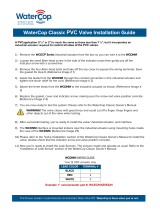
Quick Start Guide
The proven leader in household leak protection: WaterCop® is there when you’re not.
Before Installing the Valve
1. To mount the valve on the actuator, place the
O-ring on the valve in the circular indentation
around the stem.
2. Use a thin metal object that fits in the valve stem
groove to turn the valve and adjust it so that it is
aligned with the actuator.
3. Once the valve is aligned and in place, put the clip
on the four pins such that the curve is on the inside
of all four posts.
4. Make sure the Water Control Panel wiring matches
the wiring guide on page 3. To access the board,
remove the four screws on the front of the Water
Control Panel, remove the bottom and flip the front
panel so that the back is facing up.
5. Plug the Water Control Panel into a standard outlet.
KEEP FINGERS AND OTHER OBJECTS AWAY
FROM VALVE TO AVOID INJURY. You should hear
the actuator turn the valve one full cycle.
6. Test the actuator by removing the rubber stops at
both ends of the valve and checking to see the
valve position. The indicator lights on the Water
Control Panel should show the correct current
position of the valve.
7. Change valve position by pressing the UNLIT “OPEN”
or “CLOSE” button. Press the UNLIT indicator, either
“OPEN” or “CLOSE”, whichever one does not have
a LIT light next to it to tell the actuator to perform
one-half cycle.
KEEP FINGERS AND OTHER OBJECTS
AWAY FROM VALVE TO AVOID INJURY.
8. Visually verify that the valve has changed position.
9. Repeat steps 10-11 a few times by pressing the
alternating UNLIT button “OPEN” or “CLOSE” to
test and exercise the valve and actuator.
10. You are now ready to install the valve. Please refer
to the “Valve Installation” section of the Instruction
Manual for detailed instructions for various methods
of installation.
Installing and Testing Sensors
Hardwired Sensor Probes
1. To install hardwired sensor probes (WPSC), first
ensure that power is disconnected to the Water
Control Panel.
2. Open the case for the Water Control Panel and note
the side circuit board with one long terminal strip
going the full length.
3. Wire the desired number of sensor probes into the
terminal strip matching the leads of the wire with
the paired o terminals as marked by the writing on
the circuit board.
4. If the wires are in the wrong terminals, the sensor
probe will not work.
5. Once you have wired the desired number of sensor
probes into the terminal strip, close the case and
replace the screws.
6. Plug the Water Control Panel into a standard outlet
and wait for it to beep indicating it has finished its
boot up sequence.
7. SHORT the sensor probes with a metal object to
have the Water Control Panel recognize them.
The lights will remain on showing which sensor
probes the system recognizes and will flash when
something is wrong.
8. Test each sensor probe by shorting it until the
Water Control Panel display shows that the probe
has shorted and then removing the short and
waiting for the display to go back to normal.
(5-10 seconds)
9. Test each sensor probe by getting it wet, checking
that the valve did close and the alarm did sound.
10. Between each sensor probe wet test, first silence
the Water Control Panel AFTER the valve has
finished closing by pressing any button once, then
remove the source of wetness and completely dry
o the sensor probe.
11. Press the “OPEN” button once and then wait for
the solid “MODE” light to turn o before pressing
“OPEN” again to open the valve and continue.
12. Repeat steps 8-11 until all sensor probes have
been tested.







